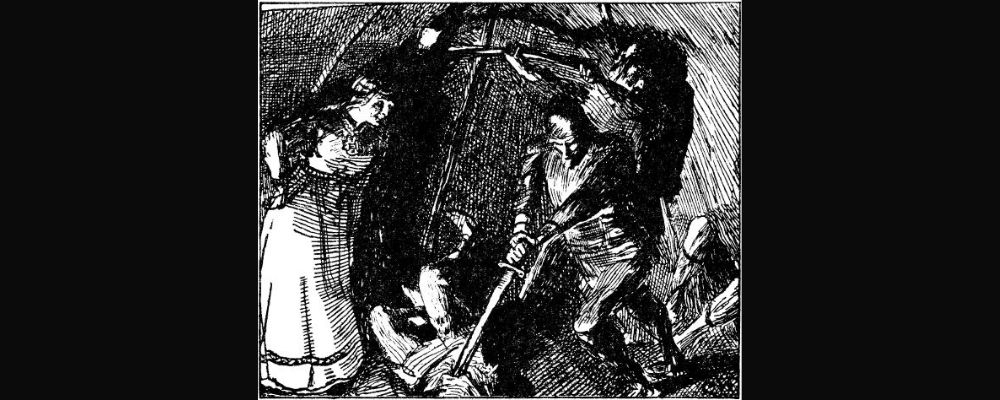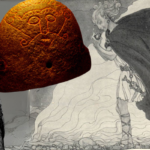The appearance of Icelandic actress and former swimmer Ragga Ragnars as Gunnhild on the TV show Vikings has inspired a lot of interest in this powerful woman.
In the program, she is a mighty shieldmaiden who was married to Jarl Olavsson. Following her husband’s death, she fell for and married Bjorn Ironside and returned as queen of Kattegat. But Gunnhild was forced to accept Bojrn’s infidelity and a second wife, Ingrid. Following Bjorn’s death, both women were invited to marry the new king Harald. While Ingrid accepts this new position of power, Gunnhild decides to take her own life rather than live without her beloved Bjorn. She disrobes at the wedding ceremony, dives into the water, and swims away to her death.
While this is a fascinating story about an interesting woman, it bears almost no resemblance to the life of the real Gunnhild, who was born around 50 years after the death of the real Bjorn Ironside.
The real Gunnhild was a queen of Norway and was known for being a witch and is an example of a powerful woman vilified for stepping outside of normal social expectations for women.
Read on to discover the true story of Gunnhild Konungamudir.
Gunnhild’s Origins
According to the 12th-century historical record, the Historiae Norwegiae, Gunnhild was a Danish princess, the daughter of king Gorm the Old of Denmark, born in around 910. She married Eric Bloodaxe, then a prince of Norway, in a common Viking political alliance.
The Icelanders, who were hostile to Eric Bloodaxe and Gunnhild because they blamed Eric’s father, Harald Fairhair, for expelling them from Norway, give Gunnhild a different origin.
They suggest that she was the daughter of a farmer from Halogaland in northern Norway, Ozur Toti. This placed her close to the Finnish border, and according to their account, as a young woman, Gunnhild was fostered by two Finnish wizards who taught her their magic.
It is noteworthy that this is foreign magic, not the Seidr magic of Viking Volva or the rune magic of Viking warriors such as Egil Skallagrimsson. This distinction represents her magic as something alien and sinister.
According to one story, the pair of wizards fostered Gunnhild and taught her magic in return for sexual favors. This created a tremendous sexual lust in Gunnhild from a young age. Nevertheless, there came a time when Gunnhild decided to leave the wizards, and she saw her opportunity when Eric Bloodaxe, the son of Harald Fiarhair, the king of Norway, showed up on an expedition.
The Icelandic sagas claim that she used her magic and sexuality to make Eric fall in love with her. She then cast a spell around the home of the wizards so that they would fall asleep when they arrived home. So disabled Eric’s men killed the pair, and Gunnhild could leave with Eric and become her queen.
This characterization sets Gunnhild up as a sinister character in Icelandic accounts and as a nemesis for the hero in Egil’s saga, who is a master of Viking magic.

Gunnhild the Ruthless
When Gunnhild arrived in Norway with her husband, she is described as ruthlessly ambitious and willing to do anything to ensure her husband’s power.
The sources claim that before Harald Fairhair’s death, she used her magic to ensure the death of Eric’s popular half-brother Halfdan Haraldsson the Black. This cleared the way for her husband to succeed to the Norwegian throne in 930.
After his accession, Gunnhild created problems between Eric and his brothers, leading him to kill four of them. He then ruled Norway with an iron fist, supported by his power-hungry wife.
An example of the couple’s self-interest can be seen in their dealing with Egil Skallagrimsson. Egil was initially friendly with King Erik and Gunnhild but came into conflict over them due to an inheritance dispute between himself and a member of the Norwegian court. Gunnhild’s response to the dispute was to order two of her brothers to kill Egil, but instead, they were killed by the hero of the saga.
This led to Egil being outlawed, and during his escape, he killed one of Eric and Gunnhild’s sons. This led Gunnhild to curse Egil, declaring that he would never find happiness in Iceland until the pair again met. Egil, in turn, put a curse on Eric and Gunnhild, mounting a horse head on a pole in a shamanic ritual.
Perhaps Egil’s curse contributed to Eric and Gunnhild being overthrown and exiled from Norway in 934. But equally responsible was general dissatisfaction with their rule, which caused local nobles to support Eric’s half-brother, Haakon the Good, to win an uprising.

Gunnhild in Exile
Gunnhild, Eric, and their multiple children were forced to leave Norway and first made their way to the Orkney Islands. Part of Norway, the Jarls there agreed to recognize Eric as their rightful king. But Eric and Gunnhild were unsatisfied with this and wanted to expand their power.
They were invited to Jorvik, modern-day York, in England by a bishop who helped Eric become the client king of Northern England. It is unclear whether agreeing to be baptized was required to seal the deal.
While in York, Egil showed up there, getting shipwrecked nearby. Perhaps this was caused by Gunnhild’s spell as the two were destined to meet again. According to Egil’s saga, Eric gave Egil one night to compose a skaldic poem to redeem himself. According to some stories, Gunnhild tried to use her magic to thwart him, turning into a small bird to spy on him and distract him. Nevertheless, the poem was so compelling that Eric spared Egil’s life, against Gunnhild’s wishes.
Eric reigned in York until he died in the Battle of Stainmore in 954.
When news of the defeat reached Gunnhild, she quickly packed up her children and headed back to Orkney. But this was just a stopover to pick up funds in the form of tribute before heading to the Danish court of Gunnhild’s brother, king Harald Bluetooth. She did leave her daughter Ragnhild behind on Orkney to marry the leading Jarl and maintain a foothold.
In Denmark, she fostered her oldest son Harald to the king, who also gave her other sons property. The Danish king then led an assault on Haakon in Norway to reclaim it.
Eventually, Haakon was killed by some of Gunnhild’s sons at the Battle of Fitjar in 961. Her son Harald Greyhid was established as the new king, and Gunnkind returned to Norway as the powerful “mother of kings”.

Gunnhild Mother of Kings
As a dowager queen, Gunnhild seems to have been a bit of a helicopter mom, pulling strings behind the scenes and manipulating her son just like she did her husband. Harald soon became just as unpopular as his father had been.
Meanwhile, Gunnhild was also very open in her sexuality. She publicly took the much younger Icelandic chieftain Hrut Herjolfsson as her lover, reportedly even having men killed to further his interests.
When Hrut returned to Iceland, she cursed him with priapism to undermine his marriage. She also took his nephew, Olaf the Peacock, as her new lower.
But the ruthlessness of the new reign meant that Gunnhild’s son was also opposed by the local lords. They joined behind Haakon Sigurdsson to kill king Harald. They were helped by Harald Bluetooth of Denmark, who summoned Harald to Denmark on the false pretense of giving him new lands and titles.
This led Gunnhild to flee to Denmark again in 977, but this time her reception was less welcoming. Harald Bluetooth had her killed by being ritually drowned in a bog. This may have been because she was considered a powerful witch, and the bog could control her powers after death.
In 1835, the body of a woman ritually killed and placed in a bog was found in Jutland in Denmark. This is sometimes described as being Gunnhild, but there’s no evidence to support this.

Gunnhild the Witch
Witches were fairly common in the Viking world. Volva were powerful seeresses that were welcomed wherever they went, and Viking warriors were also often runemasters. But Gunnhild is a witch apart, with her powers coming from a dangerous foreign source.
It is now well-established that the European witch trials were used to persecute women who lived outside of social norms and were not under the control of a father, husband, or son. The negative characterization of Gunnhild seems to represent a similar persecution.
Gunnhild seems to have been ambitious, independent, and intelligent; both her husband and son were happy to rely on her counsel when they were Viking kings. She may also have been sexually liberated. She was more than happy to have a public love affair with a younger man when the paternity of new children was no longer in question.
Perhaps her crime was not witchcraft, but rather these transgressions, and casting her as a dangerous, foreign witch was just one way to smear her name.
Whenever reading historical sources, it is important to question the motive of the source in what they have chosen to record and how they have chosen to frame it.
What do you think? Would you have liked to see Ragga Ragnars play this complicated version of Gunnhild?







